History of the Jews in Romania
This article includes a list of general references, but it lacks sufficient corresponding inline citations. (May 2019) |
Turkish Jews |
| Part of a series on |
| Jews and Judaism |
|---|
The history of the Jews in Romania concerns the Ashkenazi both of
During the reign of
Antisemitism was officially enforced under the
Between the establishment of the
On the current territory of Romania, between 290,000 and 360,000 Romanian Jews survived World War II (355,972 persons, according to statistics from the end of the war).
Today, the majority of Romanian Jews live in Israel, while modern-day Romania continues to host a modest Jewish population. In the 2011 census, 3,271 people declared themselves to be Jewish.
Early history
Jewish communities on what would later become Romanian territory were attested as early as the 2nd century AD, at a time when the Roman Empire had established its rule over Dacia. Inscriptions and coins have been found in such places as Sarmizegetusa and Orșova.[citation needed]
The existence of the
At this time both
During the first short reign of
In Wallachia,
Early Modern Age
In 1623, the Jews in
The status of Jews who had converted to Eastern Orthodoxy was established in Wallachia by Matei Basarab's Pravila de la Govora and in Moldavia by Vasile Lupu's Carte românească de învățătură.[22] The latter ruler (1634–1653) treated the Jews with consideration until the appearance of the Cossacks (1648), who marched against the Polish–Lithuanian Commonwealth and who, while crossing the region, killed many Jews; the violence led many Ashkenazi Jews from Poland took refuge in Moldavia and Wallachia, establishing small but stable communities.[23] Massacres and forced conversions by the Cossacks occurred in 1652, when the latter came to Iași on the occasion of the Vasile Lupu's daughter marriage to Timush, the son of Bohdan Khmelnytsky, and during the rule of Gheorghe Ștefan.[24]
According to
The first
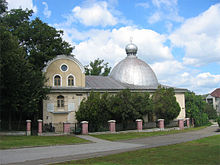
Under
In 1726, in the Moldavian borough of
Russo-Turkish Wars
During the
The community was also subject to persecutions by the locals. Jewish children were seized and forcibly baptized. Ritual-murder accusations became widespread, with one made at
During the
In
Early 19th century
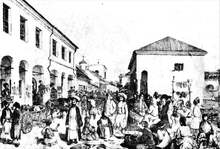
By 1825, the Jewish population in Wallachia was estimated at between 5,000 and 10,000 people, almost all
During the
Following the 1829
Despite initial interdictions under the
Before the
After the end of the
Under Alexandru Ioan Cuza

From the beginning of the reign of Alexandru Ioan Cuza (1859–1866), the first ruler (Domnitor) of the united principalities, the Jews became a prominent factor in the politics of the country. This period was, however, inaugurated by another riot motivated by blood libel accusations, begun during Easter 1859 in Galați.[9]
Regulations on clothing were confirmed inside Moldavia by two orders of Mihail Kogălniceanu, Minister of Internal Affairs (issues in 1859 and 1860 respectively).[40] Following adoption of the 1859 regulation, soldiers and civilians would walk the streets of Iași and some other Moldavian towns, assaulting Jews, using scissors to shred their clothing, but also to cut their beards or their sidelocks; drastic measures applied by the Army Headquarters put a stop to such turmoil.[40]
In 1864, Prince Cuza, owing to difficulties between his government and the general assembly, dissolved the latter and decided to submit a draft of a constitution granting
While Cuza was pressing in his demands, the Jewish community debated the method of assessment. The rich Jews, for unclear reasons, refused to advance the money, and the middle class argued that the sum would not lead to tangible enough results; Religious Jews insisted that such rights would only interfere with the exercise of their religion. Cuza, on being informed that the Jews hesitated to pay their share, inserted in his draft of a constitution a clause excluding from the right of suffrage all who did not profess Christianity.
1860s and 1870s
On December 4, 1864, Jews in Romania were barred from practicing law. When Charles von Hohenzollern succeeded Cuza in 1866 as
For the following decades, the issue of Jewish rights occupied the forefront of the
Antisemitism was carried into the PNL's mainstream, and was officially enforced under the
Nonetheless, during this same era, Romania was the cradle of
Treaty of Berlin and aftermath
When Brătianu resumed leadership, Romania faced the emerging conflict in the
Fifty-seven persons voted upon as individuals were naturalized in 1880; 6, in 1881; 2, in 1882; 2, in 1883; and 18, from 1886 to 1900; in all, 85 Jews in twenty-one years, 27 of whom in the meantime died; c. 4,000 people had obtained citizenship by 1912.[48] Various laws were passed until the pursuit of virtually all careers was made dependent on the possession of political rights, which only Romanians could exercise; more than 40% of Jewish working men, including manual labourers, were forced into unemployment by such legislation. Similar laws were passed in regard to Jews exercising liberal professions.[49]
In 1893, a piece of legislation was voted to deprive Jewish children of the right to be educated in the
The courts exacted the oath more judaico in its most offensive form – it was only abolished in 1904, following criticism in the French press. In 1892, when the United States addressed a note to the signatory powers of the Berlin treaty on the matter, it was attacked by the Romanian press. The Lascăr Catargiu government was, however, concerned – the issue was debated among ministers, and, as a result, the Romanian government issued pamphlets in French, reiterating its accusations against the Jews and maintaining that persecutions were deserved and came as retribution for the community's alleged exploitation of the rural population.
20th century–present
Before and after World War I
Land issues and Jewish presence among
During the interwar period, thousands of Jewish refugees from the
Political representation for the Jewish community in the inter-war period was divided between the Jewish Party and the Federation of Jewish Communities of Romania[59] (the latter was re-established after 1989). During the same period, a division in ritual became apparent between Reform Jews in Transylvania and usually Orthodox ones in the rest of the country[60] (while Bessarabia was the most open to Zionism and especially the socialist Labor Zionism).
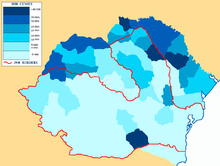
The popularity of anti-Jewish messages was, nevertheless, on the rise, and merged itself with the appeal of
The first motion to exclude Jews from professional associations came on May 16, 1937, when the Confederation of the Associations of Professional Intellectuals (Confederația Asociațiilor de Profesioniști Intelectuali din România) voted to exclude all Jewish members from its affiliated bodies, calling for the state to withdraw their licenses and reassess their citizenship.[63] Although illegal, the measure was popular and it was commented that, in its case, legality had been supplanted by a "heroic decision".[63] According to Oișteanu, the initiative had a direct influence on antisemitic regulations passed during the following year.[63]
The threat posed by the Iron Guard, the emergence of
However, Carol II himself was highly hostile to antisemitism [citation needed]. His lover, Elena Lupescu, was Jewish [citation needed], as were a number of his friends in government [who?], and he soon reverted to his original policies (that is, fiercely opposing the antisemites and fascists), but with a newly violent sting. On February 12, 1938, he used the rising violence between political groups as context to seize absolute power (a move which was tacitly supported by the liberals who had come to view him as a lesser evil in comparison to Codreanu's fascist movement). As an authentic Romanian nationalist [dubious ] (albeit, one who had a view of a Westernized, forcefully industrialized Romania at the expense of the peasants whom he viewed with disdain; making him completely the antithesis of the views of Codreanu [dubious ]), Carol was determined that Romania should not fall into the near-absolute economic and political control that many of its neighbors already had, and moved to theatrical resistance against Nazi ideology. [citation needed]
This article may be confusing or unclear to readers. In particular, Were these fascist leaders brutally killed?. (January 2016) |
The King then arrested the entire leadership of the Iron Guard, on the grounds that they were in the pay of the Nazis, and began using the same accusation against various political opponents, both to solidify his absolute control of the country as well as negatively stigmatize Germany. In November, the fourteen most important fascist leaders (the first of which being Codreanu) were "rinsed" in acid.[66]
However, Carol's policy was doomed by the reluctance of France and Britain to fight wars with the totalitarian powers of Germany, Italy and the Soviet Union. The Soviet Union attacked Romania and declared the annexation of Bukovina and Bessarabia (which was to be renamed Moldova), and when Carol turned to the only possible hope – that is, assistance from the former "eternal foe", Nazi Germany – he was angrily rejected by
In 1940, the Ion Gigurtu cabinet adopted Romania's equivalent to the Nuremberg Laws, forbidding Jewish-Christian intermarriage, and defining Jews after racial criteria (a person was Jewish if he or she had a Jewish grandparent on one side of the family).[67]
Politics
- Union of Romanian Jews
- Jewish Party of Romania
- Jewish National People's Party
- General Jewish Labour Bund in Romania
The Holocaust
Romania allied itself with Nazi Germany from 1940 to 1944. Under the dictatorship of Ion Antonescu, 380,000–400,000 Jews were murdered in the Holocaust in Romanian-controlled areas such as Bessarabia, Bukovina and Transnistria.[14]
The Iron Guard
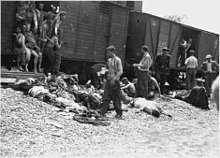
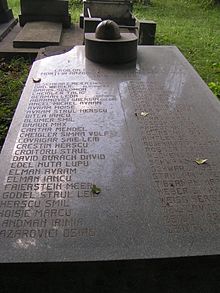
Between the establishment of the
Antonescu's régime
After Romania entered the war at the start of Operation Barbarossa atrocities against the Jews became common, starting with the Iași pogrom – on June 27, 1941, Romanian dictator Ion Antonescu telephoned Col. Constantin Lupu, commander of the Iași garrison, telling him formally to "cleanse Iași of its Jewish population", though plans for the pogrom had been laid even earlier – 13,266 Jews, according to Romanian authorities, were killed in July 1941.
In July–August 1941, the
In 1941, following the advancing
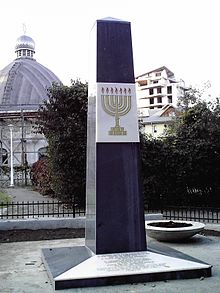
Further killings perpetrated by Antonescu's death squads (documents prove his direct orders[ in 1941 and 1942.
Antonescu's government also made plans for mass deportations of the Romanian Jews community from the rest of the country (the Regat and southern Transylvania), numbering 292,149 people (according to a May 1942 census), to Transnistria region, or, in collaboration with the German government, to the Belzec extermination camp, but these had never been carried out.[13]
The change in policy toward the Jews began in October 1942, and by March–April 1943, Antonescu permanently stopped all deportations despite German pressure,[70] as he began to seek peace with the Allies, although at the same time he levied heavy taxes and forced labor on the remaining Jewish communities. Also, sometimes with the encouragement of Antonescu's regime, thirteen boats left Romania for the British Mandate of Palestine during the war, carrying 13,000 Jews (two of these ships were sunk by the Soviets (see Struma disaster), and the effort was discontinued after German pressure was applied).
Discussions regarding the repatriation of deported Jews followed, and in January 1943, the leader of the Romanian-Jewish community Wilhelm Filderman began talks with the Romanian government in order to start repatriating Romanian Jews deported to Transnistria. On November 15, 1943, an official report of the Romanian government indicated that 49,927 Romanian Jews were alive in Transnistria (of which 6,425 were originally from the Regat). In December 1943, partial repatriation began, and in March 1944, Antonescu government ordered general repatriation for all Romanian Jews deportees from Transnistria. Between December 20, 1943, and March 30, 1944, almost 11,000 people (including orphans) were repatriated from different camps and ghettos in Transnistria. However, the decision came too late to organize the repatriation of the last large number of deportees, and the fate of tens of thousands of deportees remaining in Transnistria became unknown.[13]
Results
Historical and political situations have determined the destinies of the Romanian Jews in different ways, depending on the regions in which they were living, and proximity to the front being the most important variable.[13] The total number of deaths is not certain, but even the lowest respectable estimates run to about 250,000 Jews (plus 25,000 deported Romani, of which approximately 11,000 were murdered).[13]
According to the Wiesel Commission report released by the Romanian government in 2004, between 280,000 and 380,000 Jews were murdered or died in various forms on Romanian soil, in the war zones of Bessarabia, Bukovina, and in the occupied Soviet territories under Romanian's control (Transnistria Governorate).[12][13]
At least 15,000 Jews from the Regat were murdered in the Iași pogrom and as a result of other anti-Jewish measures. Half of the estimated 270,000 to 320,000 Jews living in Bessarabia, Bukovina, and the former Dorohoi County in Romania were murdered or died between June 1941 and November 1943. Between 45,000 and 60,000 Jews were killed in Bessarabia and Bukovina by Romanian and German troops in 1941. Between 104,522 and 120,810 deported Romanian Jews died as a result of the expulsions to Transnistria. After a wave of random initial killings, Jews in Moldavia were subject to pogroms, while those in Bessarabia, Bukovina and Dorohoi were concentrated into ghettos from which they were deported to concentration camps in the Transnistria Governorate, including camps built and run by Romanians. Romanian soldiers and gendarmes also worked with the German Einsatzkommando, the Ukrainian militia, and the SS squads of local Ukrainian Germans to massacre Jews in conquered territories east of the Romania's 1940 border. In Transnistria, between 115,000 and 180,000 indigenous Ukrainian Jews were murdered, especially in Odessa and the counties of Golta and Berezovka.[13]
At the same time, 135,000 Jews living under Hungarian control in Northern Transylvania were deported to and died in concentration and extermination camps. In addition, 5,000 Romanian Jews were murdered in the Holocaust in other countries.[13]
A majority of the Romanian Jews living within the 1940 borders did survive the war. The change in the Romanian government policy during 1942–1943 led to the survival of at least 290,000 Romanian Jews (although they were subject to a wide range of harsh conditions, including
During the postwar period, the history of the Holocaust was distorted or simply ignored by East European communist regimes. The
Holocaust denial in Romania
Decades after the Holocaust, especially during the Communist era in Romania, educating and learning about the Holocaust was considered taboo. Textbooks did mention the Holocaust in passing, but it failed to acknowledge the role of the Romanian government in the systematic murder of the Jewish and Romani people. Holocaust denial is still prevalent in Romanian society.[73]
During the Communist era from 1945 to 1989, the government influenced every part of society, including history education. When World War Two was mentioned, textbooks said that Romania was fighting against Hitler, and when the textbooks mentioned that Romania collaborated with the Nazis, it says that Romania actually lost their national independence and was occupied by Germany not that they willingly helped the Nazis and supported them. When the textbooks mentioned the killings of the Jewish people, which was not common during the time since any mention of the Holocaust was ignored and omitted, they were glossed, diminished, or distorted. When the Holocaust was mentioned, it was painted as just another broader casualty of the War in short passing and hid any responsibility of the nation while mentioning Romania's exceptional standing in Europe. Instead, the textbooks painted the Communists as the main victim of the Nazis.[74]
Holocaust education took a long time to be implemented in post-Communist Romania. Democratization in Romania started in December 1989, but it took 10 years, until 1999, for Holocaust education to be raised as an issue and for a law to pass. Although Holocaust education was accepted in 1999, it took months for the government to solidify their curriculum to show the atrocities of the Holocaust and their role in it.[75]
As of 2021, Romania has made strides to rid itself from the past of Holocaust denial. It has joined the International Holocaust Remembrance alliance in 2004, and took over chairmanship in 2016, as well as constantly organizing and sponsoring events surrounding Holocaust education.[76] In 2021, the first sentence over Holocaust denial was made in the country. The accused was Vasile Zărnescu, a former Romanian Intelligence Service (SRI) member who published several articles and a book against the veracity of the Holocaust.[77]
Post-War
According to the
Mass emigration to Israel ensued (see Bricha and Aliyah). According to Sachar, for the first two post-war years, tens of thousands of Romanian Jews left for Mandatory Palestine; the Romanian government did not try to stop them, especially due to its desire to reduce its historically suspect and now impoverished Jewish minority. Afterwards, Jewish emigration began to encounter obstacles. In 1948, the year of Israeli independence, Zionism came under renewed suspicion, and the government began a campaign of liquidation against Zionist funds and training farms. However, emigration was not completely banned; Romanian Foreign Minister Ana Pauker, herself a Jew with a father and brother in Israel, negotiated an agreement with Israeli ambassador Reuven Rubin, who himself was a Romanian Jewish immigrant to Israel, under which the Romanian government would allow 4,000 Jews a month to emigrate to Israel; this decision was at least partially influenced by a large Jewish Agency bribe to the Romanian government. This agreement applied mainly to ruined businessmen and other economically "redundant" Jews. Around this time, Israel also secured another agreement with the Romanian government, under which Romania issued 100,000 exit visas for Jews and Israel supplied Romania with oil drills and pipes to aid the struggling Romanian oil industry.[78] By December 1951, about 115,000 Romanian Jews had emigrated to Israel.[79]
During the period of transition towards a
After the proclamation of the
During the Cold War, Romania was the only communist country not to break its diplomatic relations with Israel.[85] Throughout the period of Communist rule, Romania allowed limited numbers of Jews to emigrate to Israel, in exchange for much-needed Israeli economic aid. By 1965, Israel was funding agricultural and industrial projects throughout Romania, and in exchange, Romania allowed a trickle of Jewish emigration to Israel.
When Nicolae Ceaușescu came to power in 1965, he initially ended the trade in deference to the Eastern bloc's Arab allies. However, Romania was the only Warsaw Pact nation not to break diplomatic relations with Israel after the Six-Day War of 1967,[85] and by 1969, Ceaușescu decided to exchange Jews for cash from Israel. He wanted economic independence from the Soviet Union, which was content to keep Romania a backwater and as nothing more than a supplier of raw materials, but to fund economic projects, he needed hard cash. As a result, from then until the Ceaușescu regime fell in 1989, about 1,500 Jews a year were granted exit visas to Israel in exchange for a payment of cash for every Jew allowed to leave, in addition to other Israeli aid. The exact payments were determined by the age, education, profession, employment, and family status of the emigrant. Israel paid a minimum of $2,000 per head for every emigrant, and paid prices in the range of $25,000 for doctors or scientists. In addition to these payments, Israel also secured loans for Romania and paid off the interest itself, and supplied the Romanian Army with military equipment.[78][86]
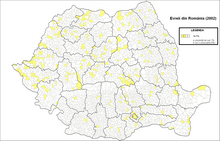
As a result of aliyah, the Romanian-Jewish community was gradually depleted. By 1987, just 23,000 Jews were left in Romania, half of whom were over 65 years old.[87] Romanian Jews became in the 1980s Israel's second largest ethnic community, outnumbered only by the Moroccans.[85]
Nevertheless, Romania still has a small Jewish community with some active synagogues, and the oldest uninterrupted Yiddish-language theater in the world.[88] With the fall of communism in Romania, Jewish cultural, social, and religious life has been undergoing a revival. Acts of antisemitism, such destruction of cemetery gravestones, continue to take place, but they are very rare.[89] In 2016, the Romanian Jewish population was estimated as ranging between 9,300 and 17,000.[90] There are also 3,000 Israeli-born people living in Romania.[91] In Romania there is also a small number of Jewish immigrants from the other parts of the world.[92] Every year, tens of Romanian Jewish families from Israel return to their native country.[93]
As of 2021, there is also a project to build a
The Federation of the Jewish Communities in Romania Party has one seat in the Chamber of Deputies, the lower house of the Romanian Parliament.
After the
Historical population
The historical Jewish population in Romania can be seen below.
The 1930 census was the only one to cover Greater Romania. Censuses in 1948, 1956, 1966, 1977, 1992, 2002 and 2011 covered Romania's present-day territory.[102] All but the 1948 census, which asked about mother tongue, had a question on ethnicity. Moldavia and Wallachia each held a census in 1859. The Romanian Old Kingdom (Regat) conducted statistical estimates in 1884, 1889 and 1894, and held censuses in 1899 and 1912. Ion Antonescu's regime also held two: a general one in April 1941, and one for those with "Jewish blood" in May 1942.
| Year | Population | Territory (Historical regions) |
|---|---|---|
| 1866 | 134,168 | ) |
| 1887 | 300,000 | Romanian Old Kingdom (Regat) (Moldavia, Wallachia, Northern Dobruja) |
| 1899 | 256,588 | Romanian Old Kingdom |
| 1930 | 728,115 | Kingdom of Romania (Greater Romania) (Moldavia, Wallachia, Dobruja, Transylvania, Bukovina, Bessarabia) |
| 1941 | 356,237 | Kingdom of Romania (Moldavia, Wallachia, Northern Dobruja, Southern Transylvania, Southern Bukovina) |
| 1956 | 146,264 | Socialist Republic of Romania (Moldavia, Wallachia, Northern Dobruja, Transylvania, Southern Bukovina) |
| 1966 | 42,888 | Socialist Republic of Romania |
| 1977 | 24,667 | Socialist Republic of Romania |
| 1992 | 8,955 | Romania |
| 2002 | 5,785 | Romania |
| 2011 | 3,271 | Romania |
Source: Demographic history of Romania
YIVO provides somewhat different population figures for Romania's Jewish population, specifically 400,000 in 1945, 280,000 in 1951, 200,000 in 1960, 70,000 in 1970, 33,000 in 1980, 17,000 in 1990, and 11,000 in 2000.[105]
Hasidic dynasties originating in today's Romania
Major groups
- Satmar, originating from Satu Mare, one of the world's largest groups [citation needed]
- Klausenburg, originating from Cluj-Napoca, the world's 9th largest group[citation needed]
- Spinks, originating from Săpânța – 10th[citation needed]
- Temishvar originating from Timișoara3rd largest in the world
Other groups
- Bohush, from Buhuși[106]
- Botoshan, from Botoșani
- Bucharest, from Bucharest
- Deyzh, from Dej
- Faltichan, from Fălticeni
- Margareten, from Marghita
- Nasod, from Năsăud
- Pashkan, from Pașcani
- Roman, from Roman
- Sasregen, from Reghin
- Seret, from Siret
- Shotz, from Suceava
- Shtefanesht, from Ștefănești
- Sighetu-Marmației
- Temishvar, originating from Timișoara
- Vasloi, originating from Vaslui
See also
- Antisemitism in Romania
- History of the Jews in Bessarabia
- History of the Jews in Bucharest
- History of the Jews in Bukovina
- History of the Jews in Carpathian Ruthenia
- History of the Jews in Hungary (details on Jewish history in Transylvania and Northern Transylvania)
- History of the Jews in Moldova
- History of the Jews in Transnistria
- Sephardic Jews in Romania
- Klezmer, a Jewish musical tradition in which Romanian influence is possibly the most important
- List of Romanian Jews
- List of synagogues in Romania
- National Day of Commemorating the Holocaust
- Patria disaster
- Romanian Jews in Israel
- Struma disaster
- Văcărești, Bucharest
Notes
- ^ "Archived copy" (PDF). Archived from the original (PDF) on 2012-02-09. Retrieved 2019-01-28.
{{cite web}}: CS1 maint: archived copy as title (link) - ^ "Comunitatea evreilor din România s-a împuţinat teribil, însă aceştia 'sunt mai ales exemple de moralitate'". Retrieved 2019-01-28.
- ^ "Archived copy" (PDF). Archived from the original (PDF) on 2014-08-12. Retrieved 2019-01-28.
{{cite web}}: CS1 maint: archived copy as title (link) - ^ "PM Sharon Meets Romanian PM". Prime Minister's Office.
- ^ a b c d Rezachevici, September 1995, p. 61
- ^ a b Oișteanu (1998), p. 239
- ^ a b Oișteanu (2003), p. 2; Rezachevici, October 1995, p. 66
- ^ a b c Cernovodeanu, p. 27
- ^ a b Oișteanu (2003), p. 2
- ^ a b A History of the Balkans 1804–1945, p. 129
- ^ a b Veiga, p. 301
- ^ a b Ilie Fugaru, Romania clears doubts about Holocaust past, UPI, November 11, 2004
- ^ a b c d e f g h i j k l International Commission on the Holocaust in Romania (2012-01-28). "Executive Summary: Historical Findings and Recommendations" (PDF). Final Report of the International Commission on the Holocaust in Romania. Yad Vashem (The Holocaust Martyrs' and Heroes' Remembrance Authority). Retrieved 2012-01-28.
- ^ a b "Murder of the Jews of Romania". www.yadvashem.org. Archived from the original on 2022-02-06. Retrieved 2022-02-23.
- ^ a b Alexandru Florin-Platon. "O necesară restituţie biografică (Carol Iancu, Alexandru Şafran: o viaţă de luptă, o rază de lumină)". Revista Contrafort. Retrieved 2019-01-28.
- ^ a b c Rezachevici, September 1995, p. 60
- ^ Djuvara, p. 179; Giurescu, p. 271
- ^ Rezachevici, September 1995, p. 59
- ^ Rezachevici, September 1995, pp. 60–61
- ^ Rezachevici, September 1995, pp. 61–62
- ^ Rezachevici, October 1995, pp. 61–62, 64–65
- ^ Rezachevici, October 1995, p. 62
- ^ Rezachevici, October 1995, pp. 62–63
- ^ Rezachevici, October 1995, p. 63
- ^ Del Chiaro; Oișteanu (1998), pp. 239–240
- ^ Oișteanu (1998), pp. 242–244
- ^ Cernovodeanu, p. 25; Giurescu, p. 271
- ^ a b Cernovodeanu, p. 25
- ^ Rezachevici, October 1995, p. 66
- ^ a b c d Cernovodeanu, p. 26
- ^ Oișteanu (1998), pp. 211–212
- ^ Cernovodeanu, p. 27; Oișteanu (2003), p. 3
- ^ a b c d Cernovodeanu, p. 28
- ^ Djuvara, p. 179; Giurescu, p. 272
- ^ Hitchins, pp. 226–227
- ^ Cernovodeanu, p. 28; Djuvara, pp. 179–180
- ^ Ornea, p. 387
- ^ Djuvara, pp. 180–182
- ^ Djuvara, p. 182
- ^ a b c Oișteanu (1998), p. 241
- ^ Islaz Proclamation, art. 21
- ^ Ornea, p. 389; Veiga, pp. 58–59
- ^ Panu, pp. 223–233
- ^ Ornea, p. 389; Panu, p. 224
- ^ For example, Panu (p. 226) stated that "the issue of [the Jews'] assimilation or the mere possibility of their assimilation were never mentioned [by antisemites], being considered an impossible occurrence altogether [...]"; in the 1890s, Caragiale evidenced the paradox in his editorial Trădarea românismului! Triumful străinismului!! Consumatum est!!!, mimicking the tone of Liberals in opposition to the Petre P. Carp government: "Yesterday, February 5, '93, yesterday, fateful and cursed day! was voted that anti-social, anti-economical, anti-patriotic, anti-national, anti-Romanian law, that law through which poverty-stricken Jews may no longer be prevented from training in certain careers!"
- ISBN 973-98272-2-5. passim; see the article on the authorfor further publication information.
- ^ Ornea, p. 390; Veiga, p. 60
- ^ a b c Ornea, p. 391
- ^ Ornea, p. 396; Veiga, pp. 58–59
- ^ Ornea, p. 396
- ^ Veiga, pp. 24–25
- ^ Veiga, p. 56
- ^ Ornea, p. 395
- ^ The Jewish-Romanian Marxist Constantin Dobrogeanu-Gherea criticised Poporanist claims in his work on the 1907 revolt, Neoiobăgia ("Neo-Serfdom"), arguing that, as favorite victims of prejudice (and most likely to be retaliated against), Jews were least likely to exploit: "[The Jewish tenant's] position is inferior to that of the exploited, for he is not a boyar, a gentleman, but a Yid, as well as to the administration, whose subordinate bodies he may well be able to satisfy, but whose upper bodies remain hostile towards him. His position is also rendered difficult by the antisemitic trend, strong as it gets, and by the hostile public opinion, and by the press, overwhelmingly antisemitic, but mostly by the régime itself – which, while awarding him all the advantages of neo-serfdom on one hand, uses, on the other, his position as a Yid to make of him a distraction and a scapegoat for the régime's sins."
- ^ Veiga, pp. 62–64
- ^ "Refugiaţi, emigranţi din URSS către România interbelică".
- ^ "Cum a gestionat România criza refugiaţilor din perioada interbelică. 100.000 de evrei, ruşi şi ucraineni s-au refugiat aici la începutul anilor '20". 29 September 2015.
- ^ "Refugiaţii evrei, din Ucraina sovietică în Basarabia română".
- ^ Veiga, p. 61
- ^ Veiga, pp. 61–62
- ^ Ornea, pp. 396–397
- ^ Oișteanu (1998), pp. 252–253; Nichifor Crainic declared in 1931 "We were not, are not and will not be anti-Semites"; nevertheless, only two years later, in 1933, he wrote "The new spirit is healthy because is anti-Semitic, anti-Semitic in doctrine and anti-Semitic in practice". Barbu Theodorescu, the secretary and bibliographer of historian Nicolae Iorga, wrote in 1938: "Romanian anti-Semitism is 100 years old. To fight against the Jew is to walk the straight line of the Romanian nation's normal development. Anti-Semitism animated the heart of the Romanian intellectual elite. Anti-Semitism is the most vital problem of Romanian prosperity." (Oișteanu (1998), p. 253)
- ^ a b c Oișteanu (1998), p. 254
- ^ Ornea, p. 397; Veiga, p. 246, 264
- ^ Royal Decree, 1938, art. 6
- ^ Glenny, Misha. The Balkans: Nationalism, War and the Great Powers 1804–1999. pp. 455–457
- ^ Decree, 1940; Ornea, pp. 391–393
- ^ Oișteanu (1998), pp. 230–231; Andrei Oișteanu suggested Wilhelm Filderman, the Jewish community's president, influenced Antonescu's decision
- ^ Oișteanu (1998), p. 231
- ^ Chapter 11 – Solidarity and Rescue, Wiesel Commission – "Final Report of the International Commission on the Holocaust in Romania" [1]
- ^ "Romania sparks Holocaust row". BBC News. June 17, 2003. Retrieved May 22, 2010.
- ^ "Romania holds first Holocaust Day". BBC News. 12 October 2004. Retrieved 24 September 2013.
- ^ Valeria Chelaru: Tradition, Nationalism and Holocaust Memory: Reassessing Antisemitism in Post-Communist Romania, pp. 81–82
- ^ Roland Clark: New models, new questions: historiographical approaches to the Romanian Holocaust, pp. 304–305
- ^ Ana Bărbulescu. (2015) Discovering the Holocaust in our past: competing memories in post-communist Romanian textbooks. Holocaust Studies 21:3, pp. 139–156.
- ^ “Holocaust Education, Remembrance, and Research in Romania." IHRA, 1 Jan. 1970, 2015. .
- ^ Marica, Irina (5 February 2021). "Bucharest court rules first sentence for Holocaust denial in Romania". Romania Insider.
- ^ a b "The Cold War's Strangest Bedfellows: How Romania Sold its Jews to Israel and What it got in Return". Forward.com. 2005-02-11. Retrieved 2014-04-28.
- ^ Sachar, Howard M.:Israel and Europe: An Appraisal in History
- ^ a b Wexler (2000)
- ^ Gordon, p. 299; Wexler (1996), p. 83
- ^ Gordon, p. 300
- ^ Gordon, p. 300; Wexler (2000)
- ^ Gordon, p. 299
- ^ a b c "Buying Romania's Jews". The Washington Post. January 14, 1990.
- ^ "Romania Sold Jews to Israel". 1991-10-24. Retrieved 2014-04-28.
- ^ "Tradition lives among few Jews left in Romania". 1987-06-20. Retrieved 2014-04-28.
- ^ "The Jewish Community of Bucharest". Beit Hatfutsot Open Databases Project. The Museum of the Jewish People at Beit Hatfutsot.
- ^ McGrath, Stephen (15 April 2019). "Anti-Semitism threatens fragile Jewish life in Romania". BBC News.
- ^ Congress, World Jewish. "World Jewish Congress". World Jewish Congress.
- ^ "Immigrant and Emigrant Populations by Country of Origin and Destination". migrationpolicy.org. Feb 10, 2014.
- ^ a b "What It's Like to Be a Rabbi in Romania – Celebrating 20 years of Chabad, where Judaism was decimated by Nazis and Communists – Chabad.org".
- ^ "Audio – Erwin Simsensohn, preşedintele Comunităţii Evreilor din Bucureşti: 'Evreii au un viitor aici, în România'". 8 February 2010.
- ^ "New Shluchim to Romania". 23 December 2014.
- ^ "About Us". Bereshit.
- ^ "Cea de-a opta lumânare de Hanuka, aprinsă în Parcul Colţea | Start Magazine". Archived from the original on 2021-03-05. Retrieved 2021-01-02.
- ^ "Home". chabadclujnapoca.com. Archived from the original on 2021-01-18. Retrieved 2021-01-02.
- ^ https://adevarul.ro/news/eveniment/sute-evrei-hasidici-venit-romania-inagura-cele-mai-mari-sinagogi-europa-est-1_618469cd5163ec42712f5b53/index.html a hotel
- ^ "Sighet – Marele rabin Aron Teitelbaum a venit special din Brooklyn, pentru a pune bazele unei băi rituale [Video] – Salut Sighet". www.salutsighet.ro.
- ^ "Oradea va avea prima școală rabinică ridicată în această parte a Europei după cel de-al Doilea Război Mondial". 26 April 2021.
- ^ "Jewish Children From Orphanage and Yeshiva Arrive Safely in Romania and Moldova l Students from Zhitomir and Dnipro make it across the border – Chabad.org".
- ^ "Lista recensămintelor populaţiei din România". Institutul Naţional de Statistică. 2011. Archived from the original on 2011-07-19. Retrieved 2011-06-03.
- ^ Institutul Central de Statistică : Recensământul General al României din 1941, April 6, in Publikationstelle, Die Bevölkerungzählung in Rumänien, 1941, Wien 1943
- ^ Republica Populară Romînă, Ghid general, Ed. pentru răspîndirea științei și culturii, Bucharest 1960, p. 94.
- ^ "YIVO | Population and Migration: Population since World War I".
- ^ "The Golden Dynasty, Chapter 15". Nishmas.org. Retrieved 2014-04-28.
References
- The 1905 Jewish Encyclopedia article Rumania, by Gotthard Deutsch, D.M. Hermalin, and Joseph Jacobs
- (in Romanian) "Evreii" ("The Jews") on Divers online bulletin
- (in Romanian) The Islaz Proclamation
- (in Romanian) Decree regarding the naturalization of Jews born in Romania, May 28, 1919
- (in Romanian) Jewish Party program, November 8, 1933
- (in Romanian) Royal Decree revising the citizenship of Jews in Romania, January 21, 1938
- (in Romanian) Decree on the judicial status of Jews in Romania, August 8, 1940
- Wiesel Commission Final Report: Executive Summary (PDF), Accessed July 2006
- (in Romanian) Ion L. Caragiale, Trădarea românismului! ("Betrayal of Romanianism!")
- Paul Cernovodeanu, "Evreii în epoca fanariotă" ("Jews in the Phanariote Epoch"), in Magazin Istoric, March 1997, pp. 25–28
- (in Romanian) Anton Maria Del Chiaro, Revoluțiile Valahiei ("The Revolutions of Wallachia"), Chapter VIII
- Neagu Djuvara, Între Orient și Occident. Țările române la începutul epocii moderne ("Between Orient and Occident. The Romanian Lands at the Beginning of the Modern Era"), Humanitas, Bucharest, 1995
- (in Romanian) Constantin Dobrogeanu-Gherea, Neoiobăgia. Curente de idei și opinii în legătură cu neoiobăgia ("Neo-Serfdom. Trends and Opinions Regarding Neo-Serfdom")
- Constantin C. Giurescu, Istoria Bucureștilor. Din cele mai vechi timpuri pînă în zilele noastre, Ed. Pentru Literatură, Bucharest, 1966
- Keith Hitchins, The Romanians, 1774–1866, Oxford University Press, Oxford, 1996
- Joseph Gordon, Eastern Europe: Romania (1954) at the American Jewish Committee (PDF)
- Andrei Oișteanu,
- "«Evreul imaginar» versus «Evreul real»" ("«The Imaginary Jew» Versus «The Real Jew»"), in Mythos & Logos, Editura Nemira, Bucharest, 1998, pp. 175–263
- (in Romanian) "Acuzația de omor ritual (O sută de ani de la pogromul de la Chișinău) (2)", in Contrafort, 2(100), February 2003
- Editura Fundației Culturale Române, Bucharest, 1995
- George Panu, Amintiri de la "Junimea" din Iași ("Recollections from the Iași Junimea"), Editura Minerva, Bucharest, 1998
- Constantin Rezachevici, "Evreii din țările române în evul mediu" ("Jews in the Romanian Lands during the Middle Ages"), in Magazin Istoric: 16th century — September 1995, pp. 59–62; 17th and 18th centuries – October 1995, pp. 61–66
- ISBN 84-7488-497-7)
- Teodor Wexler,
- "Dr. Wilhelm Filderman – un avocat pentru cauza națională a României" ("Dr. Wilhelm Filderman – an Advocate for Romania's National Cause"), in Magazin Istoric, September 1996, pp. 81–83
- (in Romanian) "Procesul sioniștilor" ("Trial of the Zionists"), in Memoria, July 2000
External links
- The Beginning of the Final Solution: Murder of the Jews of Romania Archived 2021-10-26 at the Wayback Machine on the Yad Vashem website
- Romanian Jewish Community
- The Sad End of Romanian Jewry The Huffington Post
- The Holocaust in Romania from ISurvived.org. Extensive collection of web links.
- Jewish Education Network, Jewish Education in Romanian
- (in Romanian) Romanian Jewish Portal, with links to major Romanian Jewish websites
- Romanian Jews in America Archived 2011-07-14 at the Wayback Machine, by Vladimir F. Wertsman
- Euxeinos 1/2011: Romania and the Holocaust: Delicate Reappraisal of a Fateful Past


